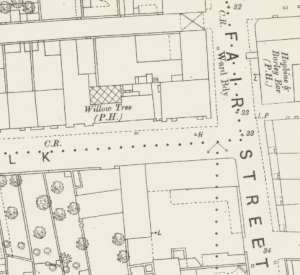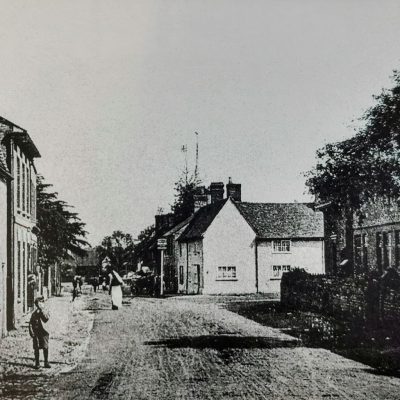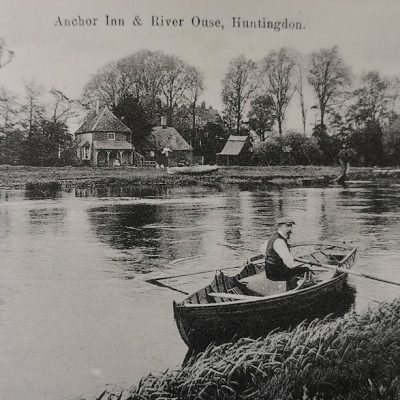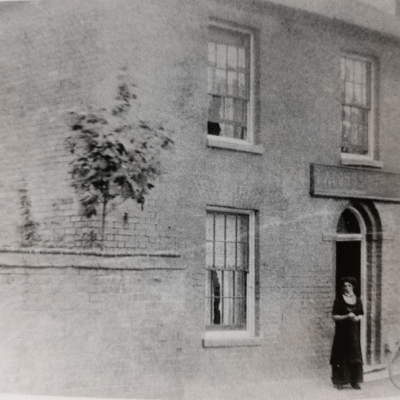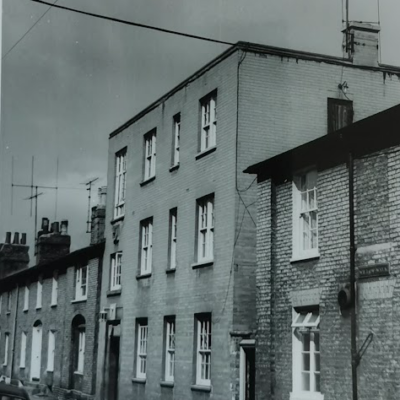Search by topic
- archaeology
- Building of Local Interest
- chapel
- charity
- church
- crime
- dressmaker
- fire
- Great Eastern Railway
- Listed building
- Mapping Relief
- medieval
- oral history
- poverty
- Public House
- Religious House
- Roman
- scholar
- school
- Then and Now
- tudor
- women
- work
- world war one
- world war two
Search by text
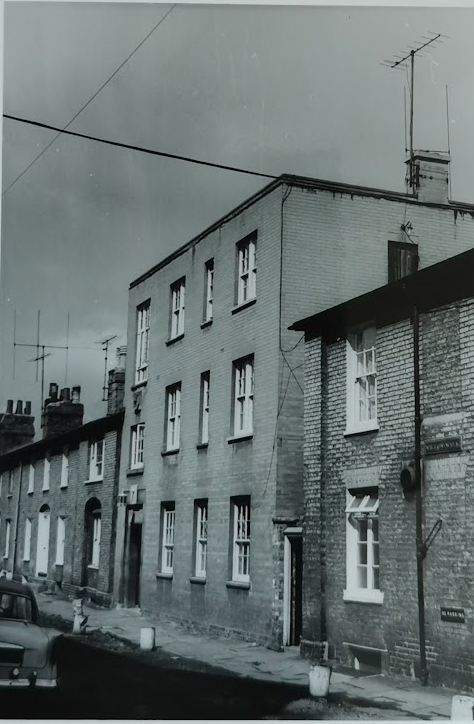 17 - 19 Willow Walk (MoC71/71)
17 - 19 Willow Walk (MoC71/71)17 – 19 Willow Walk, The Willow Tree
History of 17 Willow Walk
Built 1817
1851
(17)
William Lusher, 59, builder [and town councillor], b Norfolk (His wife Mary Ann née Coulson had died in 1849.)
Mary Lusher, daughter, 18, b Cambridge
William, 13, b Cambridge
Jane, 11, b Cambridge
Susan Coulton, wife’s sister, 52, annuitant, b Landbeach
Sarah ward, 18, servant, b Hardwick
Older William died in 1855 and son in 1861 was living at the Pickerel Inn.
(18)
William Smith, 62, proprietor of houses, b Cambridge
Matilda, 40, b Cambridge
Alexander, 18, b Cambridge
Mary Mann, 18, servant, b Quy
(19) not listed
1861
(17) Willow Tree
George Scales, 27, publican, b Norfolk
Hannah, 29, b Thriplow
William, 8, b Ely
Mary, 6, b Cambridge
George, 1, b Cambridge
Julia Ann Wallas, sister in law, 27, b Thriplow
Caroline Faircloth, 16, servant, b Thriplow
In 1871 George Scales and family were living in King Street where he was a brewer and spirit merchant
(18)
William Smith, 70, proprietor of houses, b Cambridge
Matilda, 50, b Cambridge
Alexander, 26, attorney’s general clerk, b Cambridge
Jessie, 25, b Cambridge
Susan Elberkin, 23, servant, b Abbots Ripton
1871
(17) Willow Tree
Thomas Hayward, 53, publican, b West Wickham
Thomas, 28, bookbinder finisher, b Cambridge
James, 24, b Cambridge
Caroline, 22, b Cambridge
John, 20, printer compositor, b Cambridge
Martha E, son’s wife, 29, b Cambridge
(18)
Charles Scott, 37, linen draper, b Norfolk
Mary E, 37, b Norfolk
Martha A, b Norfolk
Maude, 7, b Hants
Bessie, 3, b Cambridge
Emma Barrett, cousin, 21, housekeeper, b Norfolk
Zebulon T Benham, boarder, 22, draper’s assistant, b Hants
Mary Forby, lodger, 78, annuitant, b Suffolk
Sarah Stagg, 50, servant, b Norfolk
1881
(17) Willow Tree
Thomas Hayward, publican
James, 34
Jane Lowson, daughter, widow, 32, b Cambridge
Eliza Jubb, 23, servant, b Cambridge
(18)
Kimble Hewitt, 33, manager of drapery house, b Norfolk
Mary N, 40, b Essex
Rosetta E, 8, b Essex
Horace E, 3, b Essex
Alice E Wakeling, niece, 15, mother’s help, b Essex
Cecilia Whife, 18, servant, b Essex
Thomas Benham, lodger, 31, draper, b Hants
Marchmant Follemacki, lodger, 23, undergraduate, b Leics
1891
(17) The Willow Tree
James Hayward, 46, licensed victualler
Mary Welsh, 25, barmaid, b Cambridge
Lucy Slater, 20, barmaid, b Cambridge
(18)
Philip Nightingale, 41, cab proprietor, b Cambridge
Harriet, 26, b Herts
Charles, 17, butcher, b Cambridge
William, 14, errand boy, b Cambridge
Emily, 12, b Cambridge
Edith, 10, b Cambridge
Florence, 6, b Cambridge
Minnie, 4, b Cambridge
Philip, 2, b Cambridge
Kate Gatward, daughter, 7, b Cambridge
Caroline Miller, lodger, 78, b Cambridge
John Hodkinson, lodger, 30, draper’s daughter, b Macclesfield
1894 (CIP 2/3/1894)
A Church Army Labour Home established in Cambridge [in Ram Yard. It later moved to Trinity Place, King Street, and then, 1899, to Fair Street / Willow Walk]
A meeting, convened by the Rev. S.G. Ponsonby, vicar of Holy Sepulchre, was held in the Round Church on Friday evening, to hear an address by Captain Shingler, of the Church Army, on the Church Army Labour Homes, one of which has just been opened in Cambridge. There was not a large number present, the meeting having been convened very short notice. The Rev. S. G. Ponsonby said it had long been the desire of the Head-Quarters of the Church Army to have a labour home in this district. There was no labour home, he believed, in the eastern counties at all. They hoped by having one in so central a position as Cambridge it might be available for the neighbouring counties of Bedford, Huntingdon, etc. The home would take the character of a county home more than that of merely belonging to the town. They found there were many casuals in the different workhouses, so that there would be a continual supply of candidates for the home. They also had the hearty co-operation of the Discharged Prisoners’ Aid Society, and they might recruit some from there. They thought the home should be established in Cambridge because of the large number of undergraduates passing through the University, who, seeing a home there, might gain some knowledge of the work it did. The home dealt with that very difficulty problem now facing the country—of finding employment for the unemployed. By the rules of the home, the men were pledged to certain habits life, and it was hoped that by the aid of the home for two or three months they might be restored to habits of industry. Captain Shingler, superintendent of the Church Army Homes iu the Metropolitan District, said the homes were worked on the principle of being homes; twenty-five men was the maximum number received into any of them at one time. By having only a few they could deal with each man individually for no two men were alike The homes were for dealing not only with the lazy loafing men they saw about the public house corner. They took in that class if they were willing to work, but every man who went into the home must work. Fifty per cent of the men who had been into the homes had been put upon their feet and had begun a new life. There were different reasons why the men fell. The great cause was drink. Eighty out of every 100 who entered the homes had been brought down through drink, not only ordinary men, but men of learning and men of standing. He was glad to say that a great number of these had got back to their old positions. A great number fell through gambling. They made the men work because they did not want them to think they were receiving charity – a man thought more of the food and clothing if felt he earned it himself. In the workhouses they found, not only casuals, but a number of young men who had been born there, and who had remained there all their days. They tried to restore to them their manhood. They did not teach men trades at the homes; if they did that they would be handicapping the tradesmen. They took a man up as he was, and tried to put him back into the position he came from. Also they never pleaded with employers of labour to take their men fearing that to oblige them the employer would displace another man. They paid the men a little over trade prices for what they did and 6s. was deducted from each man’s weekly earnings for board and lodging, and they gave him a shilling for his pocket. The remainder was put by for clothing or for tools, or that he might have a few shillings when he left. Every man was required to give up intoxicating drink, and was compelled to wear the blue ribbon. They found that a great help to some of them. The men were also compelled to have a hot bath once week. Captain Shingler then gave the routine of a day’s life in the home – the men rose at six, and were at work by a quarter past; each man washed and made his bed at 7.30; prayers were said at eight and after that was breakfast. Work began at nine, dinner was at one o’clock, and work resumed at two. At 5 the day’s work was done; tea was served at six, and supper at ten. Every man was compelled to attend church on Sunday morning, and church or the Mission Hall in the afternoon, also church on one night in the week. On Saturday night a temperance meeting was held. In the evenings the dining-room was turned into a sitting-room. There were four meals a day, and very liberal fare was allowed. All the house work was done by the men; a matron superintending the cooking. They found that hot baths, good food at regular intervals, and regular habits of life made a wonderful change in the men and soon they could get a man to begin to think there was some hope for him. They did not lose sight of the men after they left the home. In connection with the home they had Samaritans’ Clothes Depot, where they received all kinds of cast-off clothing. They did not give the clothes to the men, but sold them. They did not believe in giving things away. The men took more care of them if they bought them, and they always charged something, even if it was only a shilling for a suit of clothes. All their expenses were cut down to the lowest farthing. For the Cambridge home he asked for cast-off clothing, books papers and magazines. They sold the wood which the men chopped at trade prices, never under. If a man took any intoxicating drink while in the home he was discharged. Several questions were asked and answered by Captain Shingler and Captain W. R.I. Collins who is to be the superintendent of the Cambridge Home.
1896 Cambridge Chronicle 23/10/1896
Church Army Labour Home – opening of the new premises by the Bishop of Ely
The new premises of the Cambridge labour Home, now located in Trinity Place, King Street, were opened at a meeting held under the presidency of the Lord Bishop of Ely, in the Mission Hall adjoining, yesterday (Thursday) afternoon, the New Home being afterwards dedicated by the Bishop, and inspected by a number of the visitors. The history of the Labour Home from its commencement only dates back some two and a half years. It was in the month of February, 1894, that it was first established at Cambridge, by the Church Army Social Wing, which for the purposes of the work, rented a building in Ram Yard, Round Church Street, where the first inmate was admitted on 7th March …
1899 Cambridge Chronicle 27/10/1899
Church Army Social Work: Its progress in Cambridge
Another stage in the magnificent social work of the Church Army Labour Home has to chronicled thie week. It it now about five years since a branch the Church Army’s social work was established in Cambridge, and much has been accomplished, both in Ram Yard, the original scene of the Society’s work, and in Trinity Place. The home in Trinity Place, although admirable in some respects, was unsuited in others, and the want of proper accommodation for men sometimes keenly felt. This led the Committee to make inquiries, and they were fortunate in securing a building in Fair Street, an important and busy thorough fare connecting Maids’ Causeway with Fitzroy Street, which required little alteration to turn it into a first class labour home. The new home contains thirteen men, but there is sufficient accommodation to provide comfortably for sixteen. It is under the charge of Captain and Mrs Thorne, and visitors who availed themselves of the opportunity to inspect the premises after the short dedicatory service on Tuesday afternoon, were particularly struck with the cleanliness of the dormitories, and, indeed, of the whole place. There is a charming, cosy, little chapel, capable of holding about two dozen persons. The cost of fitting up the apartment as a place of worship was entirely borne by Mrs. Foster, of Pinehurst. Over the Communion table is beautiful painting of our Lord saving St. Peter from the perils of the sea, the work and the gift of Miss Pertz. There is a library, and a reading, or common room, in the latter of which is a good pianoforte, given by Mrs. Graves. Discipline in the house is, of course, rigidly maintained, but it is a mistake to suppose that there are no entertainments for the men. Each Monday evening Mrs. Somerset and Mrs. Pollock give an entertainment, and is safe say that hardly any day in the week, except Sunday, is more eagerly looked forward to. One of great advantages of the new home over the old is that there is much more room for the men in engaged doing “stock” work. This mainly consists of chopping wood and tying it up in small bundles. The recruits are put to this work, and it is also actively pursued when no employment is found for the men engaged on work outside the home. Few probably are aware of the varied character of the work done by the men. To them nothing come amiss, and even the unfortunate householder whois in difficulties because his “general” has left to “better” herself, may find assistance by applying to the home. The incalculable good that is being done by the social wing of the Church Army need not be emphasised here, for all who take but the slightest interest in the progress of the nation cannot fail to recognise the vast number of men reclaimed from vicious life by the establishment of these homes. Mr. C. J. Clay, honorary secretary of the Discharged Prisoners’ Aid Society, Justice of the Peace for the County and Borough of Cambridge, and a gentleman of great experience in the management of men, in a brief conversation with one of our representatives spoke in terms of the highest praise of the work of the Cambridge Branch of the Society, and testified to it being the means of giving many young men discharged from prison a fresh start in life. The Discharged Prisoners’ Aid Society, which has done, and is still doing, a most valuable work, has not the organisation needed to obtain employment for all who come under their observation, and it therefore finds a useful adjunct in the Church Army Labour Home. The invitations to the short dedicatory service on Tuesday afternoon ware confined to but a few interested in the social work of the Church Army in consequence of the limited space at the Committee’s disposal. Among those present were the Rev. Prof. Stanton, who conducted the service; the Rev. C. J. Procter, Vicar of Holy Trinity; the Rev. J. George, Vicar of St. John’s, Cherryhinton; the Rev. F. Anderson, the Rev. C. A. E. Pollock. Mr. C. J. Clay, Mr. Cunliffe Foster, Capt. Crooks, Capt. Thome, and several ladies who have shown the keenest interest in the work of the home. The service was simple, but very impressive. Psalm cxv., and St. Luke xv. were read, and the only hymn sung was “Fierce raged the tempest o’er the deep.” After the service, the visitors were conducted over the home.
1901
(17 – 18) The Willow Tree Tavern
Henry C Scales, 39, licensed victualler, b Cambridge
Emma E, 35, b London
Albert, 7, b Cambridge
Hannah, 6, b Cambridge
Charles, 4, b Cambridge
Reginald, 1, b Cambridge
Emily Stearns, 18, barmaid, b Cambridge
Emily Slack, 19, servant, b Cambridge
(19) Church Army Labour Home
Thomas Thorne, 34, manager, b Dorset
Jane, 31, b Lancs
Mary A, 1, b Cambs
George Dawson, boarder, 4, groom, b Berkshire
Frederick Barnes, boarder, 37, navvy, b Lincolnshire
William Harper, boarder, 33, ?? house, b Norfolk
John Peim, boarder, 33, general labourer, b Essex
James Worrall, boarder, 35, drapers porter, b Lancs
Charles Pearson, boarder, 27, drapers porter, b Yorkshire
Arthur Melville, boarder, 22, general labourer, b Ireland
A Robert Mountain, boarder, 33, bricklayer, b Norfolk
George Blackman, boarder, 30, general labourer, b London
James Parker, boarder, 17, printer’s labourer, b London
Ashbourne Norton, boarder, 25, general labourer, b Suffolk
Thomas Brown, boarder, 33, stable man, b Scotland
1913
(17) Willow Tree
Henry Charles Scales
(19) Church Army Labour Home
Captain Frederick Edward james, officer in charge
1937 (17 &19)
Church Army Work Aid Home – Captain A Kenneway in charge
1962 (17 & 19)
Church Army Residential Hostel
In 2022 Cait Findlay wrote an article for the Cambridge News:
https://www.cambridge-news.co.uk/news/history/willow-walk-story-behind-cambridge-24418453
17-19 first became a hostel in the 1899. It was a Church Army lodging house for single young men. Early photos show young men with starched collars and waxed moustaches.
Andrew Entecott became manager of the Willow Walk Hostel in 1983. There were 36 men living in a large dormitory. Another 15 could sleep in the lounge. Neighbours along Willow Walk and fair Street would chat to residents as well as bake cakes, donate money and clothes.
In 1987 all but one person at the Willow Walk hostel moved to ‘222’ on Victoria Road. In 1990 the hostel was refurbished and 22 single rooms for men and women set up.
The Church Housing Association had run the hostel. This became part of English Churches Housing group and then Riverside Group.
In 2017 the hostel had a £1 million refurbishment of its 20 rooms with a new lounge and reception area.
In 2022 the hostel closed as part of the Cambridgeshire County’s ‘Streets to Home’ initiative.
Contribute
Do you have any information about the people or places in this article? If so, then please let us know using the Contact page or by emailing capturingcambridge@
License
This work is licensed under CC BY-NC-SA 4.0





